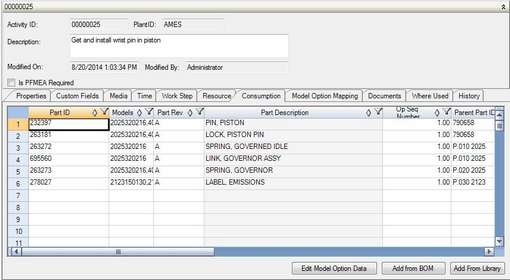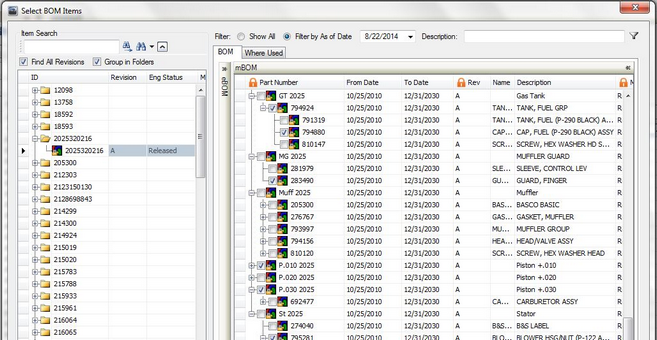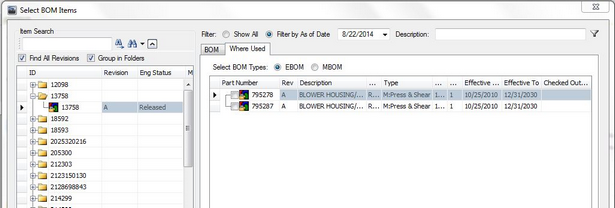If you do not see the Consumption Tab, check the Activity List search parameters to make sure you included the routing. Consumption is a local property of an activity; it is dependent on the relationship between the activity and parent processes. If you did not include a routing in your search, you are looking at the global copy of the activity, which has no parent relationships. Add the routing as a search parameter, re-select the activity, search and select the activity again, and you will see the Consumption Tab.
The consumption control associates components (parts) with an activity, which has two main benefits. Firstly, as activities move from station to station due to line balancing, the components needed at a station are reported with the task assignments. This simplifies rearranging part delivery during rate, volume, or model mix changes. Secondly, work instructions report the components associated with each activity.
To associate a component with an activity, select parts from the BOM or the component library, or type them in manually within the Consumption tab under the Activity Editor.

Consumption Tab in the Activity Editor
To add a part from the BOM, click the "Add From BOM" button at the bottom of the Consumption tab. Search for and select the part(s) from the BOM and associate the part(s) with the activity. This search tool uses a tree structure after finding a parent. Any checked boxes will be added to consumption when OK is clicked. You can add parts from either eBOM or mBOM.

Select BOM Items window appears after clicking "Add from BOM" - Displaying BOM Tab
The Where Used tab in the Select BOM Items window is used to find parent components for a known child item. It is very useful in cases where one part number is known, but where it is used is not. In the Where Used tab, search the known part and everywhere it is used will be displayed. This is the opposite of the BOM tab, as it shows higher level parts rather than lower level parts. You can also add parts from either eBOM or mBOM in the Where Used tab.

Select BOM Items window appears after clicking "Add from BOM" - Displaying Where Used Tab
By default, parts will appear sequentially in the order they were imported.
To associate a component from the Component Editor, click on the "Add From Library" button. Search for and select the part(s) from the component list and associate the part(s) with the activity. This is a standard Search for components.
Model-Option Mapping at Consumption Level
There is a 'Model' and an 'Option' column available in the Consumption Tab for consumption-specific model or option mapping. This means an activity can still be shared between models if the work content and task time is similar, even though different product configurations consume different components.
Type in the Models or Options the consumption applies to as a comma separated list. You an also click on the 'Edit Model-Option Data' button to bring up a control similar to the Model-Option Mapping Tab, allowing models and options to be added and validated before being added to the consumption row. Note: a blank in either the Model column or the Option column indicates the item applies to all models or options, respectively. The consumption-level model-option mapping is not required.
To illustrate when model-option mapping at the consumption level is helpful, consider a situation where a plant has five types of optional cooling systems for the vehicle model they build. For each cooling system, there are ten components; eight of these components are identical across all options. All ten components are assembled and installed in the same activity. In this case, we can have one activity in the database. The eight common parts are entered in the Consumption Tab and both the Model and Option columns are blank. The two unique parts for each option would also be entered in the Consumption Tab; each part would have the appropriate entry in the Option column.
This approach allows the activity to be shared among all options. Without using the Model-Option mapping for the consumed parts, the activities would have needed to be duplicated for each option.